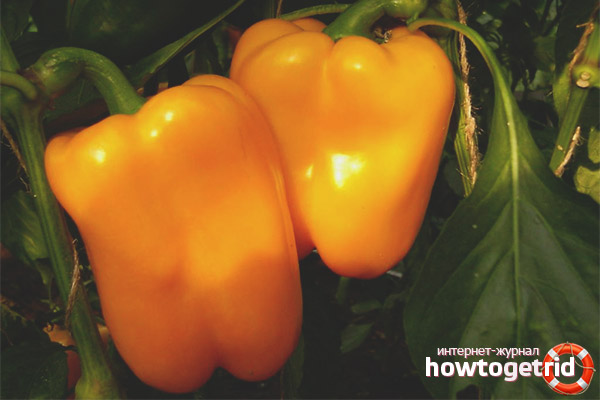The content of the article
Beautiful and sweet bell pepper is a must-have vegetable crop grown in any garden plot. Vegetables are eaten not only fresh, but also as part of a wide variety of vegetable salads, added to soups, and harvested for the winter. The proposed range of species and hybrids is striking in variety. Pepper variety Bull-calf is a worthy representative of a sweet vegetable, which has a bright orange color.
Grade description
Main agrotechnical characteristics:
- The duration of the fruiting period.
- High yield. With 1 sq.m. You can collect ripe fruits with a total weight of up to 5 kg.
- Mid-ripening. From the day the first shoot emerges until the fetus ripens, an average of 100 to 125 days passes.
- In height, the plant usually reaches about half a meter, the bush has a semi-spreading shape.
Description of the fetus:
- A rounded shape, while it is slightly narrowed to the top.
- Large pepper, the weight of one vegetable reaches up to 150 g.
- The color is light green, bright orange.
- The surface of the fruit is glossy, smooth.
- The wall is characterized by a thickness of up to 5 mm.
- The flesh of the vegetable is crisp, giving juice, aromatic and tasty.
The plant is immune to fungal infections, causing fading in other cultures and leading to their death.
Sowing seeds
At the end of sowing, the containers are tightened with a film, creating a type of greenhouse. Seedlings love heat and light, it will not be superfluous to provide it with additional light and heat sources.
The appearance of two leaves on the seedlings of the plants serves as a signal to start the picking - planting seedlings from a common container into individual ones. This contributes to the development and strengthening of the root system of young plants. Being in the general capacity, as they grow, they become cramped as a result, and they do not receive the nutrition necessary for their favorable cultivation. Plants are planted carefully, trying not to damage the root system.
Transplanted seedlings are watered and left for 2 weeks, after which it is fertilized with liquid mixtures. As such, you can use Agricola, Solution. After one and a half - two months after the appearance of the first seedlings from the seeds, the seedlings are transplanted to a permanent place of its cultivation. This can be a home-made greenhouse, a special greenhouse or an open ground area.
Planting seedlings
Heavy, dense, clay soil is unfavorable for the growth of bell pepper. Adding peat or humus will improve it, making it more suitable for fruiting a vegetable crop. Planting seedlings is recommended on land previously used for growing vegetables: onions, cucumbers, pumpkins, different varieties of cabbage, carrots, zucchini. Peppers grow heavily after potatoes, eggplant and tomatoes.
Transplanting seedlings is carried out by sequentially carrying out the following steps:
- Soil preparation. Digging the ground, leveling the surface.
- Digging holes. The distance from one row to another should be 50 cm, between the holes - 30 cm.
- Fertilizer soil. One tablespoon of complex mineral fertilizer mixed with ground is laid out in each hole.
- Young plants carefully removed from the temporary container are placed one at a time in prepared wells.
- Wells with seedlings are half asleep, watered, completely asleep.
- Garter plants. It is made at the discretion of the planting person.
When landing in open ground, you should monitor the air temperature, even at night. When it drops below +14 degrees, with the help of arcs and covering material, the plants are covered to maintain heat.
Advice! Planted different varieties of peppers can be signed or put up special plates with the inscriptions of varieties.
Care
Planted in places of their constant growth, young plants require some care, ensuring a rich harvest. Basic care includes the following mandatory procedures:
- Watering. Before flowering, the plant is watered once a week, with heat - twice a week. After the appearance of flowers and during the ripening period of vegetables, the frequency of watering increases to three times a week. For watering, water with a temperature of approximately +25 degrees should be used.
- Weeding. Weed removal from the beds is carried out as necessary. Provides improved nutrition for vegetables.
- Loosening. Fills the root system of pepper with oxygen, prevents the drying of the soil surface. Loosening should not be deep, not reaching deeper than 5 cm. This is due to the proximity of the roots to the surface of the earth. It is better to loosen the soil after irrigation or rain when it is wet.
- Fertilizer. Pepper variety Bull calf favorably reacts to fertilizer. During the seasonal period, it is required to fertilize the plant up to 5 times. As fertilizer, manure diluted with water in a percentage ratio of 1:10 is well suited. You can use a mixture of bird droppings with water in a percentage of 1:15.
- Treatment against pests and plant diseases. It is carried out if necessary, at the discretion of the owner of the site.
Getting the first harvest of pepper falls at the beginning of summer - the month of June. Proper harvesting is the removal of fruits that have reached technical maturity. In color, they will be light green, but the shape of the fetus is already fully formed. Do not wait until the color changes. Fruits that have reached biological ripeness when their color turns orange, but vegetables formed in size and shape are also removed from the plant.
Video: 10 mistakes when growing sweet pepper











Submit